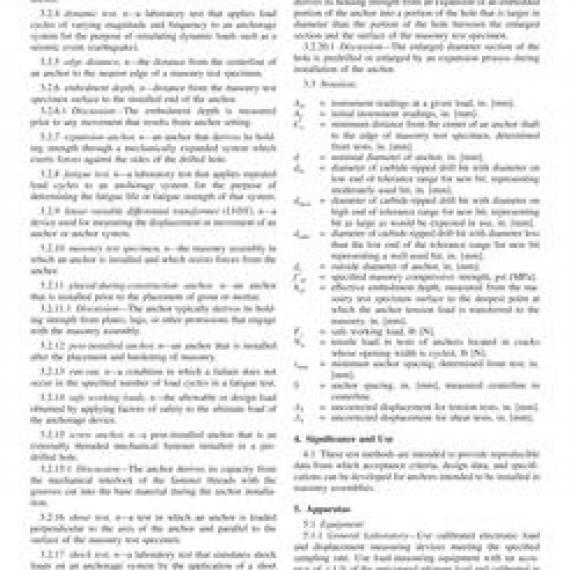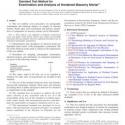No products
ASTM C1892/C1892M-20a
ASTM C1892/C1892M-20a Standard Test Methods for Strength of Anchors in Masonry
standard by ASTM International, 12/01/2020
Full Description
1.1''These test methods address the tensile and shear strengths of post-installed and placed-during-construction anchors in masonry test specimens made of masonry assemblies. Environmental exposures include freezing and thawing, moisture, decreased and elevated temperatures and corrosion. These test methods provide basic testing procedures for use with product-specific evaluation and acceptance standards and are intended to be performed in a testing laboratory. Product-specific evaluation and acceptance standards may add specific details and appropriate parameters as needed to accomplish the testing. Only those tests required by the specifying authority need to be performed.
1.2''Loadings include quasi-static, dynamic, fatigue and shock. Environmental exposures include freezing and thawing, moisture, decreased and elevated temperatures and corrosion.
1.3''These test methods are intended for use with post-installed and placed-during-construction anchors designed for installation projecting from the surface of a masonry test specimen.
1.4''This standard prescribes separate procedures for static, dynamic, fatigue and shock testing. Nothing in this standard, however, shall preclude combined tests incorporating two or more of these types of loading (such as dynamic, fatigue and shock tests in series).
1.5''Both inch-pound and SI units are provided in this standard. The testing may be performed in either system and reported in that system and the results converted to the other. However, anchor diameters, threads, and related testing equipment shall be in accordance with either inch-pound or SI provisions.
1.6''Units'''The values stated in each system are not necessarily exact equivalents; therefore, to ensure conformance with the standard, each system shall be used independently of the other, and values from the two systems shall not be combined.
1.7''This standard does not purport to address all of the safety concerns, if any, associated with its use. It is the responsibility of the user of this standard to establish appropriate safety, health, and environmental practices and determine the applicability of regulatory limitations prior to use.
1.8''This international standard was developed in accordance with internationally recognized principles on standardization established in the Decision on Principles for the Development of International Standards, Guides and Recommendations issued by the World Trade Organization Technical Barriers to Trade (TBT) Committee.


































